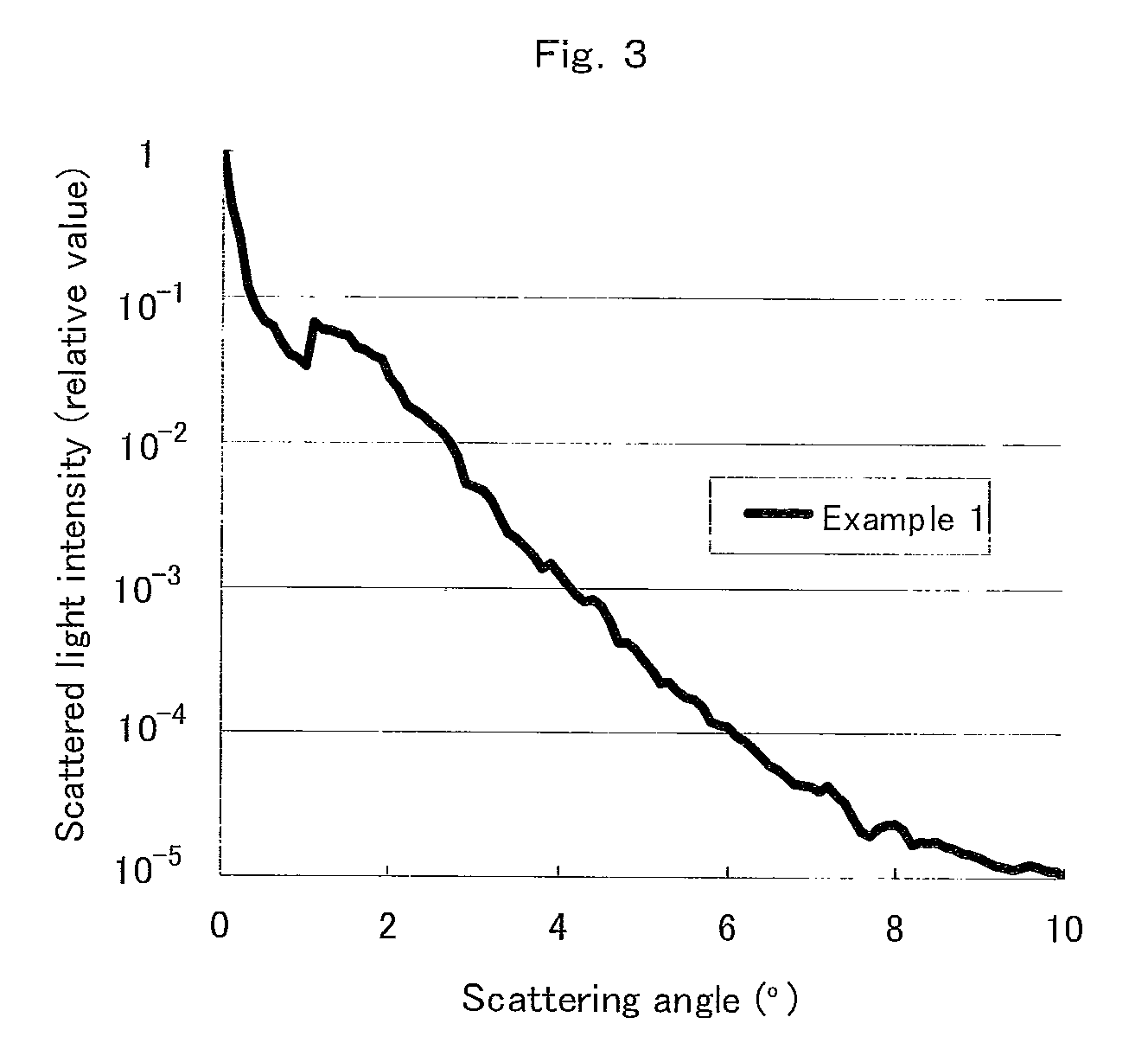Anti-glare film and process for producing the same
a technology of anti-glare film and process, which is applied in the direction of identification means, instruments, manufacturing tools, etc., can solve the problems of limited flexibility in the design difficult control of the uneven surface structure, and unsatisfactory external appearance of the film, etc., to achieve excellent anti-glare effect, high adhesiveness, and excellent anti-glare
- Summary
- Abstract
- Description
- Claims
- Application Information
AI Technical Summary
Benefits of technology
Problems solved by technology
Method used
Image
Examples
example 1
[0139]In a mixed solvent containing 35.1 parts by weight of methyl ethyl ketone (MEK) and 10.8 parts by weight of 1-butanol were dissolved 38.0 parts by weight of trimethylolpropane triacrylate (manufactured by DAICEL-CYTEC Company, Ltd., TMPTA), 14.6 parts by weight of an acrylic resin having a polymerizable unsaturated group(s) at a side chain thereof [1-methoxy-2-propanol (MMPG) solution of a compound in which 3,4-epoxycyclohexenylmethyl acrylate is added to part of carboxyl groups of a (meth)acrylic acid-(meth)acrylate copolymer; manufactured by Daicel Chemical Industries, Ltd., ACAZ321M, solid content: 44% by weight], and 1.6 parts by weight of a cellulose acetate propionate (acetylation degree=2.5%, propionylation degree=46%, number average molecular weight in terms of polystyrene: 75,000; manufactured by Eastman, Ltd., CAP-482-20). In the resulting solution, 0.8 parts by weight of IRGACURE 184 and 0.8 parts by weight of IRGACURE 907 (each manufactured by Ciba Specialty Chemic...
example 2
[0143]In a mixed solvent containing 39.0 parts by weight of methyl ethyl ketone (MEK), 9.0 parts by weight of 1-butanol, and 4.9 parts by weight of 1-methoxy-2-propanol (MMPG) were dissolved 33.4 parts by weight of trimethylolpropane triacrylate (manufactured by DAICEL-CYTEC Company, Ltd., TMPTA), 12.7 parts by weight of an acrylic resin having a polymerizable unsaturated group(s) at a side chain thereof which was the same as used in Example 1, [manufactured by Daicel Chemical Industries, Ltd., ACAZ321M, solid content: 44% by weight; 1-methoxy-2-propanol (MMPG) solution], and 1.0 part by weight of a cellulose acetate propionate, which was the same as used in Example 1, (manufactured by Eastman, Ltd., CAP-482-20). In the resulting solution, 0.7 parts by weight of IRGACURE 184 and 0.7 parts by weight of IRGACURE 907 (each manufactured by Ciba Specialty Chemicals K.K.) as photoinitiators and 0.2 parts by weight of a silicone acrylate (manufactured by DAICEL-CYTEC Company, Ltd.; EB1360)...
example 3
[0145]In a mixed solvent containing 41.0 parts by weight of methylethylketone (MEK), 9.5 parts by weight of 1-butanol, and 6.0 parts by weight of 1-methoxy-2-propanol (MMPG) were dissolved 30.5 parts by weight of trimethylolpropane triacrylate (manufactured by DAICEL-CYTEC Company, Ltd., TMPTA), 11.8 parts by weight of an acrylic resin having a polymerizable unsaturated group(s) at a side chain thereof, which was the same as used in Example 1, [manufactured by Daicel Chemical Industries, Ltd., ACAZ321M, solid content: 44% by weight; 1-methoxy-2-propanol (MMPG) solution], and 1.3 parts by weight of a cellulose acetate propionate, which was the same as used in Example 1, (manufactured by Eastman, Ltd., CAP-482-20). In the resulting solution, 0.7 parts by weight of IRGACURE 184 and 0.7 parts by weight of IRGACURE 907 (each manufactured by Ciba Specialty Chemicals K.K.) as photoinitiators and 0.2 parts by weight of a silicone acrylate (manufactured by DAICEL-CYTEC Company, Ltd.; EB1360)...
PUM
| Property | Measurement | Unit |
|---|---|---|
| total light transmittance | aaaaa | aaaaa |
| width | aaaaa | aaaaa |
| haze | aaaaa | aaaaa |
Abstract
Description
Claims
Application Information
 Login to View More
Login to View More - R&D
- Intellectual Property
- Life Sciences
- Materials
- Tech Scout
- Unparalleled Data Quality
- Higher Quality Content
- 60% Fewer Hallucinations
Browse by: Latest US Patents, China's latest patents, Technical Efficacy Thesaurus, Application Domain, Technology Topic, Popular Technical Reports.
© 2025 PatSnap. All rights reserved.Legal|Privacy policy|Modern Slavery Act Transparency Statement|Sitemap|About US| Contact US: help@patsnap.com


